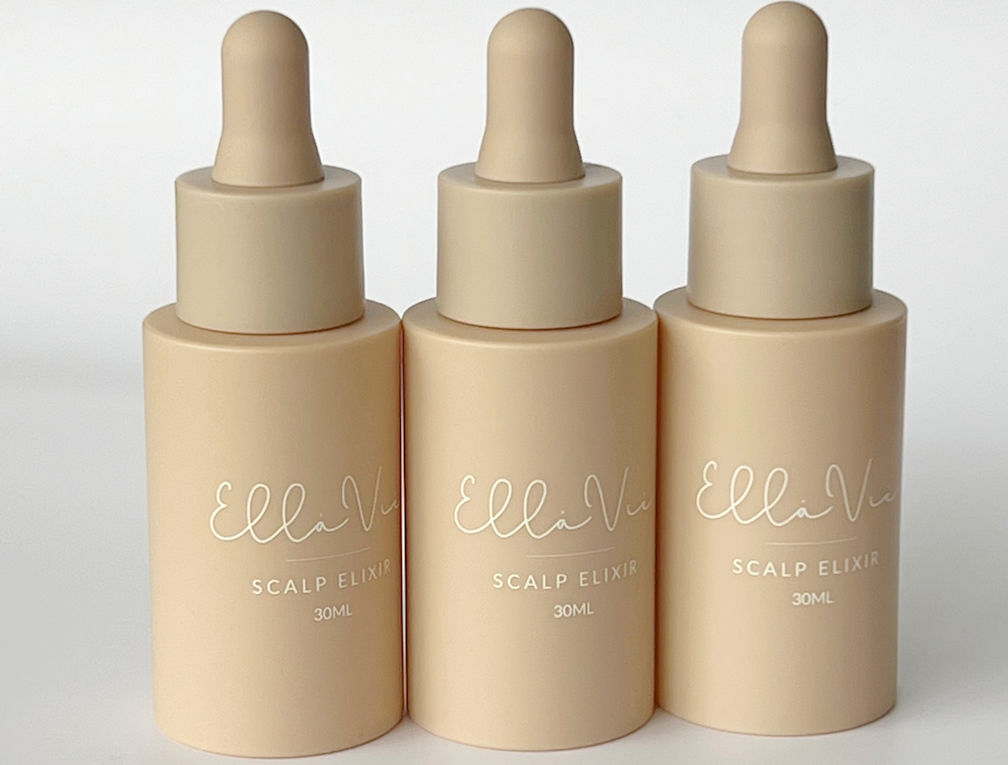Hair loss in Females – Expert Insight
- Written by Rafaela Shkambi – RN, Trichologist & Founder of Ella Vie Scalp Elixir.

Hair loss is a hot topic that shows no signs of slowing down.
In the past, a huge focus has been placed on male hair loss, but interestingly, approximately 49% of women will be affected by hair loss throughout their lives.
Certified Trichologist, Registered Nurse & Founder of Ella Vie Scalp Elixir, Rafaela Shkambi, explains a few conditions that can contribute to, or cause hair loss.
Please note: This article is for educational purposes only and it is not recommended to self-diagnose. It is always recommended that you see your doctor for a more accurate diagnosis.
There are about 10 types of hair loss but we will cover 6 most common types we have encountered and their causative agents.
Androgenetic Alopecia, the most common type of hair loss, known as female or male pattern hair loss. This condition occurs due to the effect of dihydrotestosterone (DHT) on the hair follicles of the scalp, causing them to shrink and eventually to fall. Diagnosis is based on clinical presentation, clinical history and family history of AGA.
Alopecia Areata (AA) is a non-scarring form of hair loss and has a hereditary component. Studies have shown that 20% of patients diagnosed with AA have at least one close relative with AA. It is considered an autoimmune disease and is usually associated with thyroid disease, vitiligo and atopy. AA affects the scalp and beard manifesting as smooth round patches of complete hair loss.
Telogen Effluvium (TE) different from AGA and AA, tends to affect the scalp area uniformly. TE can be acute or chronic. Acute telogen effluvium is characterised by hair shedding for less than 6 months. It usually comes on after a period of extreme stress or sickness, childbirth, nutritional deficiency, crash diets and can be drug related. The trigger usually happens 2-4 months prior to the hair shedding commencing.
Traction Alopecia is a result of constant tension applied to hair through certain hairstyles: tight ponytails, hair braiding, weft hair extensions, pulling from hair straighteners and hot rollers. TA affects predominantly the scalp hair and can be controlled by switching to more relaxed hairstyles.
Anagen Effluvium (AE) different form TE, the abnormal hairs break off. The most common cause of this type of hair loss is understood to be radiation therapy and chemotherapy. AE affects 80-90% of scalp hairs and hair loss becomes apparent within 1-4 weeks and in most cases, it is reversible. However, irreversible hair loss has also been reported.
Trichotillomania is the act of impulse hair pulling and regardless of the negative impact this has on someone’s social and work life, people affected by this condition are unable to stop. People affected by trichotillomania can also be experiencing some type of psychological illness such as depression, anxiety etc. Affected areas are usually areas easy to access which include the frontal part of the scalp and face.
Once you have a diagnosis, there are a few ways you can manage hair loss depending on the causative agent. There are prescription medications, medicated topical agents and more natural options such as scalp oil blends. It is also important that you have a well-balanced diet and learn to manage stress levels.
Ella Vie Scalp Elixir is formulated with 11 different oils, in their purest form, to tackle hair loss and scalp conditions. Each ingredient is scientifically proven to improve scalp health and aid hair growth. It is a unique combination of potent antioxidants, DHT blockers, vessel dilators, antimicrobial and antifungal agents to help tackle hair loss in multiple ways. The waterless solution ensures no preservatives are needed and potency is not diluted.
Hair loss can be a very complex condition and challenging to treat. In Rafaela’s experience, hair health starts on the inside, combined with lifestyle and scalp care.
Rafaela Shkambi – RN, Trichologist & Founder of Ella Vie Scalp Elixir.

